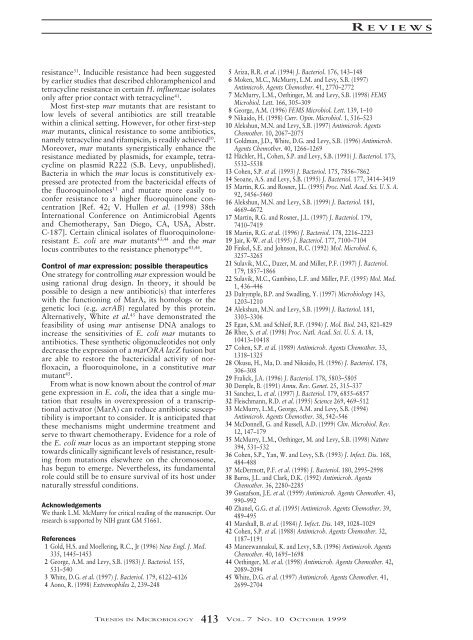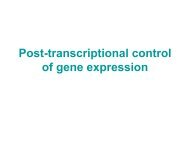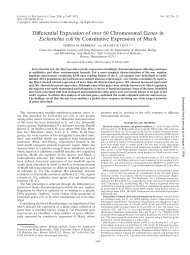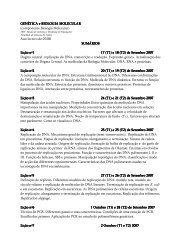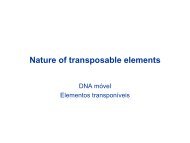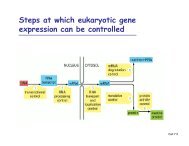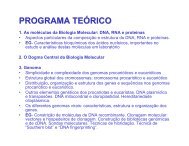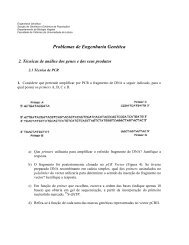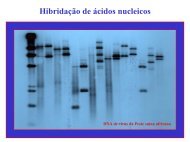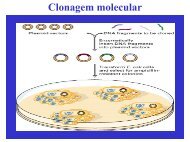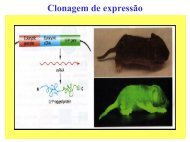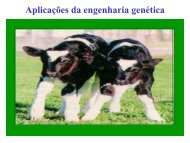The mar regulon: multiple resistance to antibiotics and other toxic ...
The mar regulon: multiple resistance to antibiotics and other toxic ...
The mar regulon: multiple resistance to antibiotics and other toxic ...
- No tags were found...
Create successful ePaper yourself
Turn your PDF publications into a flip-book with our unique Google optimized e-Paper software.
R EVIEWS<strong>resistance</strong> 31 . Inducible <strong>resistance</strong> had been suggestedby earlier studies that described chloramphenicol <strong>and</strong>tetracycline <strong>resistance</strong> in certain H. influenzae isolatesonly after prior contact with tetracycline 41 .Most first-step <strong>mar</strong> mutants that are resistant <strong>to</strong>low levels of several <strong>antibiotics</strong> are still treatablewithin a clinical setting. However, for <strong>other</strong> first-step<strong>mar</strong> mutants, clinical <strong>resistance</strong> <strong>to</strong> some <strong>antibiotics</strong>,namely tetracycline <strong>and</strong> rifampicin, is readily achieved 10 .Moreover, <strong>mar</strong> mutants synergistically enhance the<strong>resistance</strong> mediated by plasmids, for example, tetracyclineon plasmid R222 (S.B. Levy, unpublished).Bacteria in which the <strong>mar</strong> locus is constitutively expressedare protected from the bactericidal effects ofthe fluoroquinolones 11 <strong>and</strong> mutate more easily <strong>to</strong>confer <strong>resistance</strong> <strong>to</strong> a higher fluoroquinolone concentration[Ref. 42; V. Hullen et al. (1998) 38thInternational Conference on Antimicrobial Agents<strong>and</strong> Chem<strong>other</strong>apy, San Diego, CA, USA, Abstr.C-187]. Certain clinical isolates of fluoroquinoloneresistantE. coli are <strong>mar</strong> mutants 43,44 <strong>and</strong> the <strong>mar</strong>locus contributes <strong>to</strong> the <strong>resistance</strong> phenotype 43,44 .Control of <strong>mar</strong> expression: possible therapeuticsOne strategy for controlling <strong>mar</strong> expression would beusing rational drug design. In theory, it should bepossible <strong>to</strong> design a new antibiotic(s) that interfereswith the functioning of MarA, its homologs or thegenetic loci (e.g. acrAB) regulated by this protein.Alternatively, White et al. 45 have demonstrated thefeasibility of using <strong>mar</strong> antisense DNA analogs <strong>to</strong>increase the sensitivities of E. coli <strong>mar</strong> mutants <strong>to</strong><strong>antibiotics</strong>. <strong>The</strong>se synthetic oligonucleotides not onlydecrease the expression of a <strong>mar</strong>ORA lacZ fusion butare able <strong>to</strong> res<strong>to</strong>re the bactericidal activity of norfloxacin,a fluoroquinolone, in a constitutive <strong>mar</strong>mutant 45 .From what is now known about the control of <strong>mar</strong>gene expression in E. coli, the idea that a single mutationthat results in overexpression of a transcriptionalactiva<strong>to</strong>r (MarA) can reduce antibiotic susceptibilityis important <strong>to</strong> consider. It is anticipated thatthese mechanisms might undermine treatment <strong>and</strong>serve <strong>to</strong> thwart chem<strong>other</strong>apy. Evidence for a role ofthe E. coli <strong>mar</strong> locus as an important stepping s<strong>to</strong>ne<strong>to</strong>wards clinically significant levels of <strong>resistance</strong>, resultingfrom mutations elsewhere on the chromosome,has begun <strong>to</strong> emerge. Nevertheless, its fundamentalrole could still be <strong>to</strong> ensure survival of its host undernaturally stressful conditions.AcknowledgementsWe thank L.M. McMurry for critical reading of the manuscript. Ourresearch is supported by NIH grant GM 51661.References1 Gold, H.S. <strong>and</strong> Moellering, R.C., Jr (1996) New Engl. J. Med.335, 1445–14532 George, A.M. <strong>and</strong> Levy, S.B. (1983) J. Bacteriol. 155,531–5403 White, D.G. et al. (1997) J. Bacteriol. 179, 6122–61264 Aono, R. (1998) Extremophiles 2, 239–2485 Ariza, R.R. et al. (1994) J. Bacteriol. 176, 143–1486 Moken, M.C., McMurry, L.M. <strong>and</strong> Levy, S.B. (1997)Antimicrob. Agents Chem<strong>other</strong>. 41, 2770–27727 McMurry, L.M., Oethinger, M. <strong>and</strong> Levy, S.B. (1998) FEMSMicrobiol. Lett. 166, 305–3098 George, A.M. (1996) FEMS Microbiol. Lett. 139, 1–109 Nikaido, H. (1998) Curr. Opin. Microbiol. 1, 516–52310 Alekshun, M.N. <strong>and</strong> Levy, S.B. (1997) Antimicrob. AgentsChem<strong>other</strong>. 10, 2067–207511 Goldman, J.D., White, D.G. <strong>and</strong> Levy, S.B. (1996) Antimicrob.Agents Chem<strong>other</strong>. 40, 1266–126912 Hächler, H., Cohen, S.P. <strong>and</strong> Levy, S.B. (1991) J. Bacteriol. 173,5532–553813 Cohen, S.P. et al. (1993) J. Bacteriol. 175, 7856–786214 Seoane, A.S. <strong>and</strong> Levy, S.B. (1995) J. Bacteriol. 177, 3414–341915 Martin, R.G. <strong>and</strong> Rosner, J.L. (1995) Proc. Natl. Acad. Sci. U. S. A.92, 5456–546016 Alekshun, M.N. <strong>and</strong> Levy, S.B. (1999) J. Bacteriol. 181,4669–467217 Martin, R.G. <strong>and</strong> Rosner, J.L. (1997) J. Bacteriol. 179,7410–741918 Martin, R.G. et al. (1996) J. Bacteriol. 178, 2216–222319 Jair, K-W. et al. (1995) J. Bacteriol. 177, 7100–710420 Finkel, S.E. <strong>and</strong> Johnson, R.C. (1992) Mol. Microbiol. 6,3257–326521 Sulavik, M.C., Dazer, M. <strong>and</strong> Miller, P.F. (1997) J. Bacteriol.179, 1857–186622 Sulavik, M.C., Gambino, L.F. <strong>and</strong> Miller, P.F. (1995) Mol. Med.1, 436–44623 Dalrymple, B.P. <strong>and</strong> Swadling, Y. (1997) Microbiology 143,1203–121024 Alekshun, M.N. <strong>and</strong> Levy, S.B. (1999) J. Bacteriol. 181,3303–330625 Egan, S.M. <strong>and</strong> Schleif, R.F. (1994) J. Mol. Biol. 243, 821–82926 Rhee, S. et al. (1998) Proc. Natl. Acad. Sci. U. S. A. 18,10413–1041827 Cohen, S.P. et al. (1989) Antimicrob. Agents Chem<strong>other</strong>. 33,1318–132528 Okusu, H., Ma, D. <strong>and</strong> Nikaido, H. (1996) J. Bacteriol. 178,306–30829 Fralick, J.A. (1996) J. Bacteriol. 178, 5803–580530 Demple, B. (1991) Annu. Rev. Genet. 25, 315–33731 Sanchez, L. et al. (1997) J. Bacteriol. 179, 6855–685732 Fleischmann, R.D. et al. (1995) Science 269, 469–51233 McMurry, L.M., George, A.M. <strong>and</strong> Levy, S.B. (1994)Antimicrob. Agents Chem<strong>other</strong>. 38, 542–54634 McDonnell, G. <strong>and</strong> Russell, A.D. (1999) Clin. Microbiol. Rev.12, 147–17935 McMurry, L.M., Oethinger, M. <strong>and</strong> Levy, S.B. (1998) Nature394, 531–53236 Cohen, S.P., Yan, W. <strong>and</strong> Levy, S.B. (1993) J. Infect. Dis. 168,484–48837 McDermott, P.F. et al. (1998) J. Bacteriol. 180, 2995–299838 Burns, J.L. <strong>and</strong> Clark, D.K. (1992) Antimicrob. AgentsChem<strong>other</strong>. 36, 2280–228539 Gustafson, J.E. et al. (1999) Antimicrob. Agents Chem<strong>other</strong>. 43,990–99240 Zhanel, G.G. et al. (1995) Antimicrob. Agents Chem<strong>other</strong>. 39,489–49541 Marshall, B. et al. (1984) J. Infect. Dis. 149, 1028–102942 Cohen, S.P. et al. (1988) Antimicrob. Agents Chem<strong>other</strong>. 32,1187–119143 Maneewannakul, K. <strong>and</strong> Levy, S.B. (1996) Antimicrob. AgentsChem<strong>other</strong>. 40, 1695–169844 Oethinger, M. et al. (1998) Antimicrob. Agents Chem<strong>other</strong>. 42,2089–209445 White, D.G. et al. (1997) Antimicrob. Agents Chem<strong>other</strong>. 41,2699–2704TRENDS IN MICROBIOLOGY 413VOL. 7 NO. 10 OCTOBER 1999


